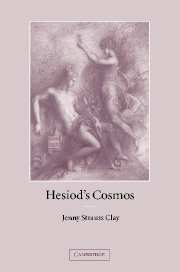Book contents
- Frontmatter
- Contents
- Preface
- Acknowledgments
- List of abbreviations
- Introduction
- 1 Orientations: the Theogony
- 2 Orientations: the Works and Days
- 3 Overtures
- 4 The origins and nature of mankind
- 5 The two Prometheuses
- 6 Perspectives on gods and men
- 7 Hybrids
- Conclusion: Hesiod and Calchas at Aulis
- Bibliography
- Indexes
5 - The two Prometheuses
Published online by Cambridge University Press: 04 August 2010
- Frontmatter
- Contents
- Preface
- Acknowledgments
- List of abbreviations
- Introduction
- 1 Orientations: the Theogony
- 2 Orientations: the Works and Days
- 3 Overtures
- 4 The origins and nature of mankind
- 5 The two Prometheuses
- 6 Perspectives on gods and men
- 7 Hybrids
- Conclusion: Hesiod and Calchas at Aulis
- Bibliography
- Indexes
Summary
ἐκρίνετο τί θεὸς καὶ ἄνθρωπος ἐν τῇ ᡋΜηκώνῃ.
In Mekone it was decided what is a god and what a human being.
(Scholium on Theogony 535)If the anthropogonic myths we have examined trace the origins of mankind, the myth of Prometheus describes its condition. As a testimony to the signal importance he assigns to it, Hesiod relates the story twice, once in the middle of the Theogony (521–616), and again at the beginning of the Works and Days (47–105). This double telling, more or less contemporaneously, by the same poet offers a unique insight into Hesiod's myth-making; it also reveals how the story could be manipulated and adjusted to fit the very different contexts in which it appears. In the first case, the account, the longest sustained narrative in the Theogony, is placed in the middle of the poem between Zeus's deposition of his father Cronus and the Titanomachy, where the Olympians successfully defeat the gods of the previous generation. Thus the story patently – since Athena and Hephaestus, who are not yet born, take part in the action – breaks the expected temporal sequence. In the Works and Days, the myth, set close to the beginning, clearly serves as an introduction to Hesiod's exhortations to his brother Perses.
The narrative itself has frequently been viewed as a rather unsatisfactory synthesis of heterogeneous elements.
- Type
- Chapter
- Information
- Hesiod's Cosmos , pp. 100 - 128Publisher: Cambridge University PressPrint publication year: 2003

